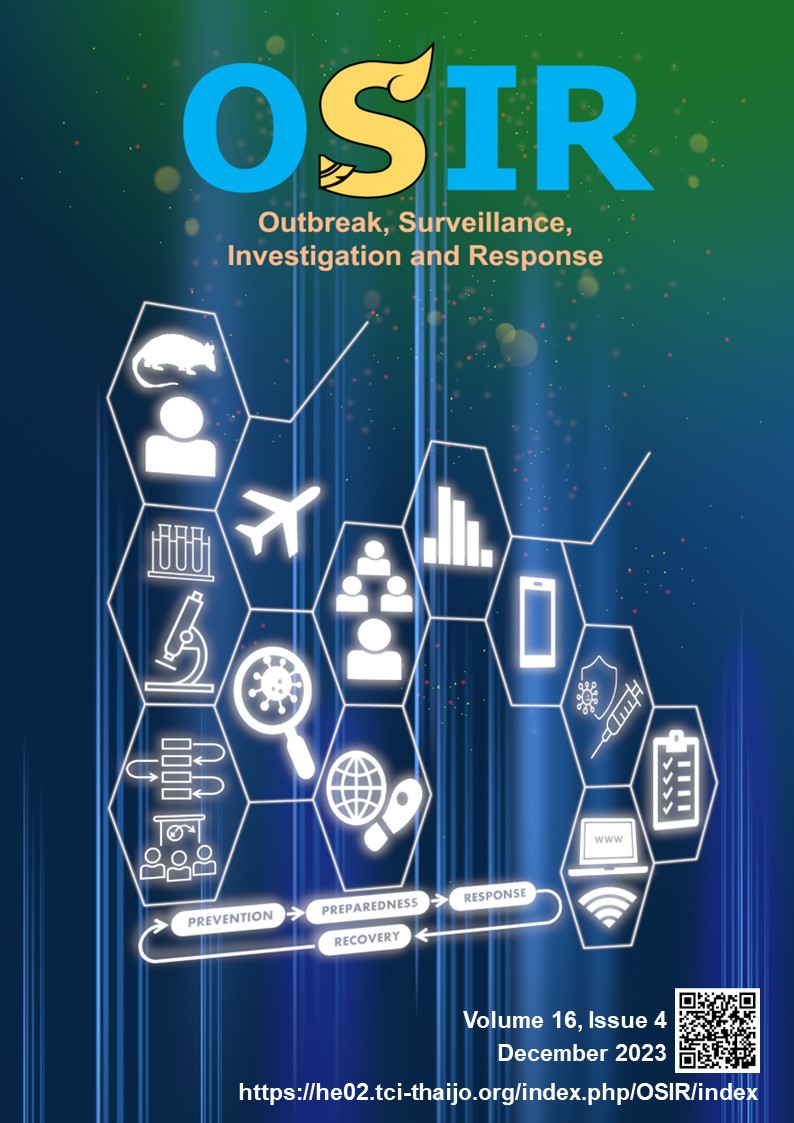SARS-CoV-2 Infections, Vaccination, and Vaccine Effectiveness in Thailand, January 2021–January 2022: Results of a Cohort Study in Four Provinces
DOI:
https://doi.org/10.59096/osir.v16i4.264238Keywords:
antibodies, SARS-CoV-2, seroprevalence, Thailand, vaccine effectivenessAbstract
We implemented a sero-epidemiological survey of SARS-CoV-2 antibodies in an age-stratified sample of people in Thailand. We used two-stage sampling employing stratified random sampling with official residence lists to recruit 1,200 people in three age strata in Bangkok, Chiang Mai, Nakhon Phanom and Phuket provinces. Serum was screened for SARS-CoV-2 antibodies using enzyme-linked immunosorbent assay (ELISA) and microneutralization assay. We collected symptom and vaccination data weekly and tested participants who met a COVID-19-like illness (CLI) case definition by rRT-PCR. Serum for SARS-CoV-2 antibodies was collected and tested again in January 2022. We estimated vaccine effectiveness using multi-level Poisson regression with propensity score stratification to control for differences in healthcare-seeking behavior. Of 1,200 people enrolled in January 2021, 5 (0.4%; 95% confidence interval 0.16–1.16) had antibody detected by ELISA at baseline, and none tested positive by microneutralization. From January 2021 to January 2022, 23% of participants (278/1,200) reported CLI and 18% of CLI cases (50/278) tested positive for SARS-CoV-2 by rRT-PCR. In January 2022, 87% of participants (955/1,101) had SARS-CoV-2 antibodies detected by ELISA. Ninety-eight percent (1,034/1,045) received at least one dose of COVID-19 vaccine and did not get infection. Vaccine effectiveness against hospitalization was 72% for two doses and 98% for three doses of any vaccine. Low SARS-CoV-2 seroprevalence in 2021 suggests that Thailand successfully prevented COVID-19 infections through non-pharmaceutical interventions during the first year of the pandemic. High seroprevalence in 2022 was driven by vaccination.
References
Mathieu E, Ritchie, H, Rodes-Guirao L, Appel C, Gavrilov D, Giattino C, et al., Coronavirus Pandemic (COVID-19) [Internet]. [place unknown]: OurWorldData.org; 2020 [cited 2022 Jul 25]. <https://ourworldindata.org/coronavirus>
Mathieu E, Ritchie H, Ortiz-Ospina E, Roser M, Hasell J, Appel C, et al., A global database of COVID-19 vaccinations. Nat Hum Behav. 2021 Jul;5(7):947–53. doi:10.1038/s41562-021-01122-8.
World Health Organization. Coronavirus disease (COVID-19) technical guidance: the unity studies: early investigation protocols [Internet]. Geneva: World Health Organization; [cited 2021 Mar 27]. <https://www.who.int/emergencies/diseases/novel-coronavirus-2019/technical-guidance/early-investigations>
Lerdsamran H, Mungaomklang A, Iamsirithaworn S, Prasertsopon J, Prasert K, Intalapaporn P, et al. Evaluation of different platforms for the detection of anti-SARS coronavirus-2 antibodies, Thailand. BMC Infect Dis. 2021;21(1):1213. doi:10.1186/s12879-021-06921-y.
Weidner L, Gansdorfer S, Unterweger S, Weseslindtner L, Drexler C, Farcet M, et al. Quantification of SARS-CoV-2 antibodies with eight commercially available immunoassays. J Clin Virol. 2020;129:104540. doi:10.1016/j.jcv.2020.104540.
Ong DSY, de Man SJ, Lindeboom FA, Koeleman JGM. Comparison of diagnostic accuracies of rapid serological tests and ELISA to molecular diagnostics in patients with suspected coronavirus disease 2019 presenting to the hospital. Clin Microbiol Infect. 2020 Aug; 26(8):1094.e7–10. doi:10.1016/j.cmi.2020.05.028.
GeurtsvanKessel CH, Okba NMA, Igloi Z, Bogers S, Embregts CWE, Leijten L, et al. An evaluation of COVID-19 serological assays informs future diagnostics and exposure assessment. Nat Commun. 2020;11(1):3436. doi:10.1038/s41467-020-17317-y.
Bureau of Registration Administration, Department of Provincial Administration. Population statistics from the civil registration [Internet]. Pathumthani: Bureau of Registration Administration; [cited 2022 Jul 26]. <https://stat.bora.dopa.go.th/stat/statnew/statMONTH/statmonth/#/displayData>
Bean J, Kuri-Cervantes L, Pennella M, Betts MR, Meyer NJ, Hassan WM. Multivariate indicators of disease severity in COVID-19. Sci Rep. 2023 Mar;13(1):5145. doi:10.1038/s41598-023-31683-9.
Department of Disease Control. COVID-19 Situation reports [Internet]. Nonthaburi: Department of Disease Control; 2020 [cited 2021 May 7]. <https://ddc.moph.go.th/viralpneumonia/eng/situation.php>
Rostami A,.Sepidarkish M, Leeflang MMG, Riahi SM, Shiadeh MN, Esfandyari S, et al. SARS-CoV-2 seroprevalence worldwide: a systematic review and meta-analysis. Clin Microbiol Infect. 2021 Mar;27(3):331–40. doi:10.1016/j.cmi.2020.10.020.
Johns Hopkins Coronavirus Resource Center. Cumulative cases by days since 50th confirmed case [Internet]. Baltimore (MD): Coronavirus Resource Center, Johns Hopkins University and Medicine; 2021 [cited 2021 Jun 8]. <https://coronavirus.jhu.edu/data/cumulative-cases>
Singkiao C, Sripu C, Deemuenwai W. COVID-19 Vaccine Side Effects in Children Aged 5-11 years in Thailand. JPMAT [Internet]. 2023 Jan 17 [cited 2023 Oct. 24];12(3):624-36. <https://he01.tci-thaijo.org/index.php/JPMAT/article/view/257715>
Ministry of Public Health (TH). Guidelines for surveillance and investigation of coronavirus disease 2019 (COVID-19) [Internet]. Nonthaburi: Department of Disease Control; 2020 Feb 21 [cited 2021 May 24]. 42 p. <https://ddc.moph.go.th/viralpneumonia/eng/file/guidelines/G_en_21022020.pdf>
Ministry of Public Health (TH). Guidance for integrated management of state quarantine facilities [Internet]. Nonthaburi: Department of Disease Control; 2020 Jun 3 [cited 2021 Jun 12]. 36 p. <https://ddc.moph.go.th/viralpneumonia/eng/file/guidelines/g_guarantine_190620new.pdf>
Mahikul W, Chotsiri P, Ploddi K, Pan-Ngum W. Evaluating the impact of intervention strategies on the first wave and predicting the second wave of COVID-19 in Thailand: a mathematical modeling study. Biology (Basel). 2021 Jan 22;10(2):80. doi:10.3390/biology10020080.
Thailand Ministry of Public Health; World Health Organization Thailand. Joint intra-action review of the public health response to COVID-19 in Thailand [Internet]. Geneva: World Health Organization; 2020 Jul 24[cited 2020 May 24]. 45 p. <https://www.who.int/docs/default-source/searo/thailand/iar-covid19-en.pdf>
Corwin A, Plipat T, Phetsouvanh R, Mayxay M, Xangsayarath P, Quynh Mai LT, et al., The impact of preparedness in defying COVID-19 pandemic expectations in the Lower Mekong Region: a case study. Am J Trop Med Hyg. 2021 Jan 28;104(4):1519–25. doi:10.4269/ajtmh.20-1499.
Ssentongo P, Ssentongo AE, Voleti N, Groff D, Sun A, Djibril MB, et al., SARS-CoV-2 vaccine effectiveness against infection, symptomatic and severe COVID-19: a systematic review and meta-analysis. BMC Infect Dis. 2022 May 7;22(1):439. doi:10.1186/s12879-022-07418-y.
Feikin DR, Higdon MM, Abu-Raddad LJ, Andrews N, Araos R, Goldberg Y, et al. Duration of effectiveness of vaccines against SARS-CoV-2 infection and COVID-19 disease: results of a systematic review and meta-regression. Lancet. 2022 Mar 5;399(10328): 924–44. doi:10.1016/S0140-6736(22)00152-0.
Andrews N, Stowe J, Kirsebom F, Toffa T, Gallagher E, Gower C, et al. Covid-19 vaccine effectiveness against the Omicron (B.1.1.529) variant. N Engl J Med. 2022 Apr 21;386(16): 1532–46. doi:10.1056/NEJMoa2119451.
Downloads
Additional Files
Published
How to Cite
Issue
Section
License
Copyright (c) 2023 Outbreak, Surveillance, Investigation & Response (OSIR) Journal

This work is licensed under a Creative Commons Attribution-NonCommercial-NoDerivatives 4.0 International License.









